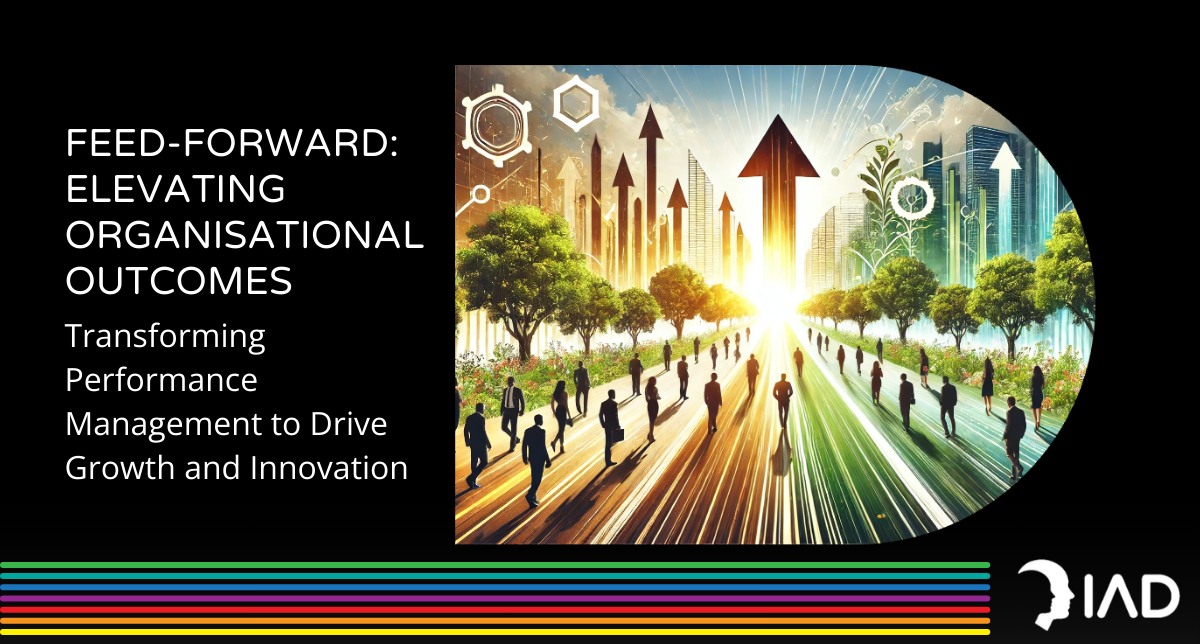The Future Leader: Balancing Innovation and Humanity with AI
Navigating the Intersection of Technology and Human-Centric Leadership

As Artificial Intelligence (AI) rapidly evolves, its presence is reshaping leadership in unexpected ways. Leaders today are tasked with more than just managing teams—they're navigating a world where AI drives innovation and decision-making at speeds never seen before. This brings remarkable potential for efficiency and progress, but it also introduces new challenges, particularly when it comes to maintaining the human touch in leadership.
Leaders now face a critical question: How can they leverage AI’s capabilities without losing sight of what makes their people—and their organisations—thrive? The challenge is balancing the power of automation with the nuances of human judgment. AI can streamline processes, but it can’t replace the compassion and ethical foresight that define great leadership (yet!). As businesses move further into the AI age, leaders must consider the ethical implications of their decisions—ensuring that the technology serves both the business and the people within it.
To succeed in the AI era, leaders need to develop a combination of technological proficiency and a deep commitment to human-centric decision-making. But this balance is no easy feat. It requires a new way of thinking—one that focuses on intentionality and long-term sustainability for both business and people.
Is your leadership team prepared to make the complex decisions AI will require of them, balancing humanity with progress?
AI as a Leadership Catalyst: Innovation with Responsibility
AI has become an undeniable catalyst for innovation. From automating routine tasks to providing predictive insights through data analysis, AI has transformed the way businesses operate. Leaders can now harness this technology to drive efficiency, uncover new opportunities, and make faster, more informed decisions. For instance, AI-powered tools can predict customer behaviours, streamline hiring processes, and optimise operations in real time.
However, this newfound power brings with it significant ethical challenges. While AI offers unprecedented capabilities, it also has the potential to depersonalise decision-making and, in some cases, amplify biases already present in the data. A system designed to streamline may unintentionally exclude diverse perspectives or make decisions without the nuance of human judgment. Furthermore, the fear of job automation looms large, with many employees questioning their future roles in AI-driven environments.
Leaders are, therefore, at a crossroads. How do they embrace AI’s potential while ensuring their decisions remain grounded in ethics, inclusivity, and humanity? This is where the concept of Dynamic Intelligence, a core component of Constructed Development Theory (CDT) becomes critical. Leaders with heightened Dynamic Intelligence—the ability to think in more complex, nuanced ways—are better equipped to navigate these ethical dilemmas. Developing their Dynamic Intelligence helps leaders become more self-aware and intentional in their decision-making, allowing them to balance AI’s benefits with the responsibility to maintain a human touch in every choice they make.
The question is not whether to adopt AI, but how to do so responsibly. Can your leadership team rise to this challenge?
Dynamic Intelligence: The Key to Ethical AI Integration
The complexity of leading in the AI era requires more than just technical proficiency—it demands a heightened level of Dynamic Intelligence. This concept, rooted in Constructed Development Theory (CDT), gives leaders the ability to think with greater Intention, Awareness, and Choice leading to greater flexibility. By developing their Dynamic Intelligence, leaders can navigate the intricate ethical landscapes that AI presents.
AI pushes leadership beyond traditional decision-making paradigms. It accelerates the speed and scope of decisions, from automated customer service to AI-driven performance evaluations. But while AI processes data at lightning speed, human complexity—our ability to factor in compassion, ethics, and the long-term impact of choices—remains essential. This is where Dynamic Intelligence comes into play. Leaders with high levels of Dynamic Intelligence are equipped to integrate technological precision with human insight, ensuring that both business outcomes and people’s needs are respected.
One key aspect of Dynamic Intelligence is the ability to access and balance Cognitive Intentions. Leaders with high Dynamic Intelligence can adopt multiple perspectives simultaneously, enabling them to make more thoughtful and inclusive decisions. For example, using the Observer Perspective allows leaders to step back and view a situation from a neutral, unbiased standpoint—an essential skill when evaluating the impact of AI on diverse groups. At the same time, leaders must balance their Internal and External Reference Cognitive Intentions to ensure that decisions are not only strategically sound but also align with the broader human and ethical needs of their organisations.
The ability to handle these complexities, both technological and human, is what sets future-ready leaders apart. For HR Leaders, the critical question becomes: Can your leadership team shift their thinking to manage AI’s complexity while keeping humanity at the forefront?
Balancing Humanity and AI: Practical Applications of CDT
While AI can revolutionise processes, its true potential is unlocked when it is used ethically and with humanity at its core. Leaders must go beyond simply adopting AI technologies—they need to embed ethical foresight into their strategic decisions. This is where Constructed Development Theory (CDT) offers practical tools to help leaders foster both innovation and human-centric leadership.
One of CDT’s most powerful applications is the Dynamic Intelligence Development System™ (DIDS™). This system helps leaders enhance their Cognitive Intentions, allowing them to become more self-aware, make deliberate choices, and consider broader ethical implications. Leaders who cultivate Dynamic Intelligence are better equipped to anticipate and manage AI’s potential risks, from bias in machine learning models to the unintended consequences of automation on workforce dynamics.
Building a culture where these values are prioritised is essential. This involves creating a Consciously Constructing Culture (CCC), where AI is used responsibly, and human development is woven into the fabric of daily operations. In a CCC, leaders and employees alike are continuously developing their Dynamic Intelligence, ensuring decisions made with AI are aligned with ethical, inclusive, and sustainable practices. This approach not only fosters trust and integrity but also enhances innovation—when individuals feel that their contributions matter, they are more likely to collaborate effectively with AI systems.
HR Leaders can play a pivotal role in shaping this culture by providing practical leadership tools to support the ethical integration of AI. One such tool is the Identity Compass®, which profiles leaders’ cognitive patterns, helping them to understand and refine their decision-making processes. By recognising which Cognitive Intentions are driving their decisions, leaders can make more balanced, ethical choices .
The challenge is to develop leaders who can harness AI’s potential without losing sight of the people behind the data. How prepared is your leadership team to strike this delicate balance?
Long-Term Sustainability: A Holistic Approach to Leadership Development
Sustainable leadership in the age of AI requires more than short-term strategies. Leaders must be prepared to navigate the complexities of AI not only today but in the years to come. Those who balance AI’s technological potential with human-centric decision-making will set the foundation for long-term success—not just for their businesses but also for their people.
Dynamic Intelligence is a key factor in ensuring this sustainability. Leaders with high Dynamic Intelligence are not only more adaptable but also better equipped to manage AI’s volatility. They can respond to unforeseen challenges, such as shifts in technology, market demands, or workforce expectations, with greater agility and resilience . This adaptability is crucial for organisations looking to thrive in an uncertain and fast-paced world.
The benefits extend beyond leadership. Organisations that invest in leadership development through Constructed Development Theory (CDT) and the Dynamic Intelligence Development System™ (DIDS™) can experience stronger employee engagement, higher retention rates, and a culture rooted in ethical practices . When leaders embody these principles, they create an environment where employees feel valued, contributing to both business outcomes and people’s well-being.
As AI continues to evolve, the need for resilient, ethically-minded leaders will only grow. How can your organisation ensure its leadership is prepared for the long haul?
As AI continues to reshape the business landscape, leaders must do more than adopt new technologies—they need to ensure that ethical, human-centric decision-making remains at the core of their strategy. This balance between innovation and humanity is crucial for long-term sustainability, and it begins with developing Dynamic Intelligence.
By leveraging the insights of Constructed Development Theory and the Dynamic Intelligence Development System™, HR Leaders can cultivate leaders who are not only proficient in navigating AI’s complexities but are also deeply committed to maintaining a culture of ethical foresight, inclusivity, and resilience.
The future belongs to those who can seamlessly integrate AI with the human touch. How are you preparing your leaders to make balanced, ethical decisions in the age of AI?
If you would like to discuss how we can help your organisation to make balanced ethical decisions please get in touch
Alternatively, you can read more about the IAD's approach to leadership development.
All Rights Reserved | Adult Development (UK) Ltd




